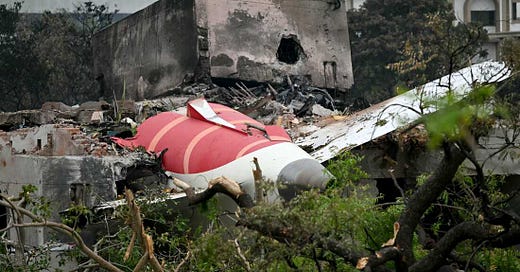Air India flight 171: A preliminiary investigation.
What are some possible causes, and current findings about this new disaster.
On June 12, 2025, Air India Flight AI171, a Boeing 787-8 Dreamliner, crashed mere minutes after lifting off from Sardar Vallabhbhai Patel International Airport in Ahmedabad, Gujarat, en route to London. All but one of the 242 passengers lost their lives. The jet lost altitude rapidly at a reported 650 feet and landed in a residential area just under two kilometres from the runway. In the immediate aftermath, Indian aviation authorities have recovered one of the aircraft’s two black boxes, which records cockpit audio and flight trajectories, and the aviation authorities have called for help from the U.S. National Transportation Safety Board (NTSB) and Federal Aviation Administration (FAA) to survey the wreckage and analyse performance data.
Because the crash involved the Boeing 787 aircraft, pinpointing the blame on Boeing seems difficult. The 787’s design and service history suggest a fundamental airframe or systems defect being a cause is highly unlikely. Over 1,100 Dreamliners have flown more than 120 million flight hours without a single fatal hull loss leading up to the disaster. Furthermore, because of Boeing’s track record, the aircraft was likely subject to rigorous FAA and EASA certifications and inspections. Thus, currently, investigators are concentrating on operational factors such as engine failures, maintenance practices, and runway conditions.
Specifically, video analysis has shown that as the aircraft descended, the ram air turbine (RAT) was engaged in the final seconds of Flight AI171. The RAT mechanism only engages when both primary power sources (both engines) do not deliver hydraulic and electrical power. The sudden extension of this small wind-driven turbine beneath the fuselage strongly indicates a simultaneous loss of thrust from both engines, as the RAT is designed to deploy automatically only under dual-engine failure or total electrical/hydraulic power loss. But, because investigations are still in their primary form, we cannot come to any conclusions and can only pray for the wellbeing of the families affected.






very informative article.
Thanks for the analysis.